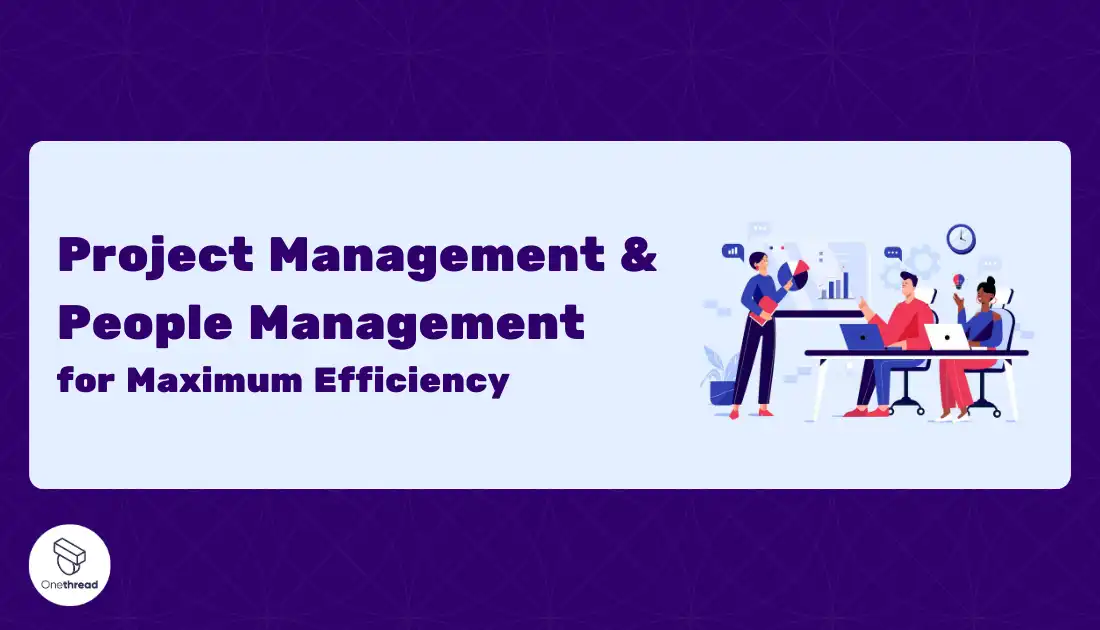Managing projects and people is crucial to business success, yet often overlooked. Gallup studies show that poor project management leads to failed projects between 5% to 15% which costs companies over $50 – $150 billion per year alone in the USA.
Project Management orchestrates project completion within set timelines and budgets, focusing on tasks and goals. Conversely, People Management emphasizes leadership, motivation, and team development, nurturing a positive work culture.
Without proper people management, projects suffer from a lack of coordination and motivation. So what’s the solution? Combining effective project management techniques like agile with people-focused leadership.
The result? Engaged employees who collaboratively drive projects to deliver real impact.
Want to learn how to bridge the gap and build amazing teams? Read on for tips and tricks!
Key Takeaways:
- Integrating project and people management boosts efficiency and team morale, driving projects to success.
- Strong communication and team understanding are crucial for avoiding common management pitfalls.
- Diverse, well-supported teams lead to innovative solutions and improved project outcomes.
- Onethread enhances project and people management by providing tools for efficient planning and collaboration. Its features foster open communication, support diverse team dynamics, and adapt to evolving project management trends.
What is Project Management?
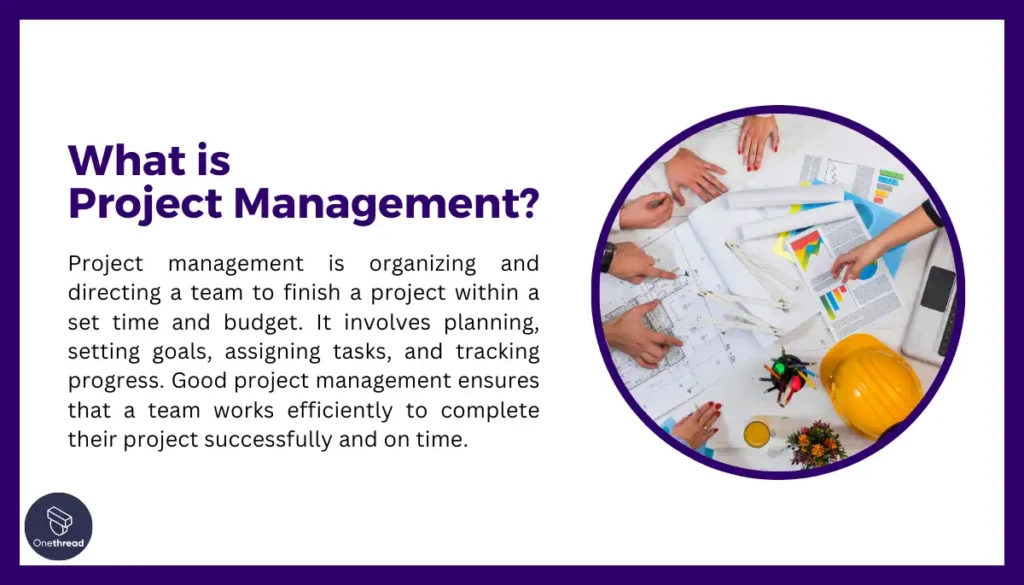
Project management is organizing and directing a team to finish a project within a set time and budget. It involves planning, setting goals, assigning tasks, and tracking progress. Good project management ensures that a team works efficiently to complete their project successfully and on time.
Project management is a critical discipline in the business world, ensuring that projects are delivered efficiently, on time, and within budget. Here’s a detailed look at its importance and benefits:
Importance of Project Management:
- Ensures Clear Focus and Objectives: Project management helps define clear goals, ensuring everyone understands the project’s purpose and objectives.
- Optimizes Resource Use: It allows for the efficient use of resources, including time, money, and personnel, avoiding waste and overallocation.
- Risk Management: Identifies potential risks early on, allowing for proactive measures to avoid or mitigate them, ensuring smoother project execution.
- Enhances Customer Satisfaction: By delivering projects on time and within budget, project management helps meet or exceed stakeholder expectations, leading to higher customer satisfaction.
- Improves Team Coordination: Facilitates better communication and coordination among team members, ensuring everyone is on the same page and working towards common goals.
Benefits of Project Management:
- Increased Efficiency: Project management methodologies like Agile or Waterfall streamline processes, making it easier to complete tasks efficiently and effectively.
- Better Quality Outcomes: Emphasizes quality control at every stage, leading to higher quality deliverables that meet or exceed expectations.
- Enhanced Collaboration: Encourages open communication and collaboration within the team, fostering a productive work environment.
- Strategic Alignment: Ensures that every project aligns with the broader strategic goals of the organization, contributing to long-term success.
- Competitive Advantage: By completing projects more efficiently and effectively, organizations can stay ahead of competitors and adapt more quickly to market changes.
- Financial Savings: Efficient resource management and risk mitigation can lead to significant cost savings, positively impacting the bottom line.
- Professional Development: Provides team members with opportunities to develop new skills and expertise, enhancing their career prospects.
- Adaptability: Offers frameworks and tools to manage change effectively, making organizations more resilient and adaptable in the face of uncertainty.
What is People Management?
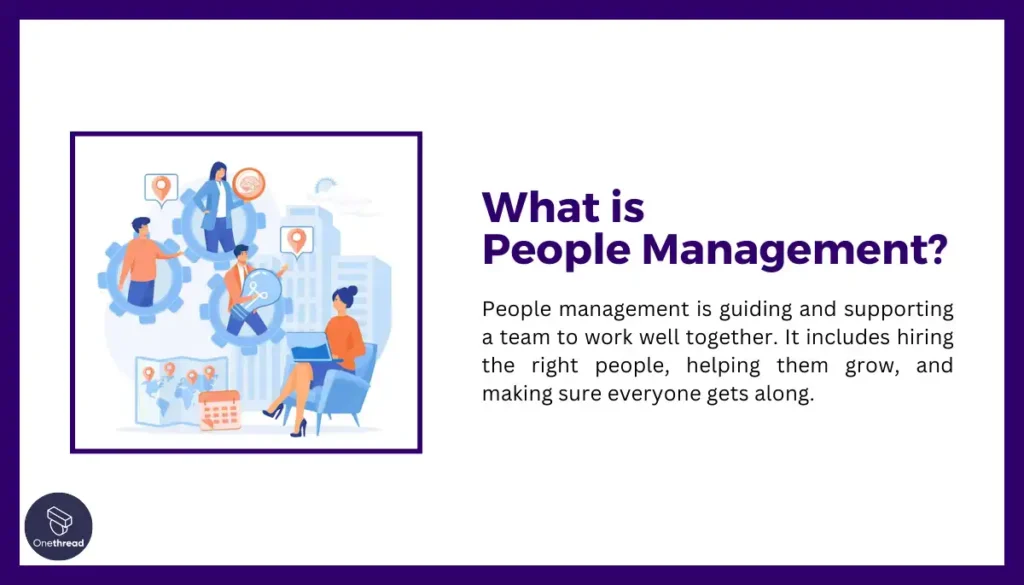
People management is guiding and supporting a team to work well together. It includes hiring the right people, helping them grow, and making sure everyone gets along. People management revolves around:
- Understanding people
- Communication
- Collaboration
- Knowledge, and
- Development.
Good people management helps a team feel happy and work better, leading to great results in their jobs.
People management, also known as human resource management, plays a pivotal role in the success of any organization by focusing on the most valuable asset: its employees. Understanding its importance and benefits is crucial for fostering a productive, motivated, and engaged workforce.
Importance of People Management:
- Maximizes Employee Performance: Effective people management strategies, supported by tools like performance management software, help in identifying and utilizing the strengths of each employee, maximizing their performance and contribution to the organization.
- Promotes Employee Satisfaction and Retention: By addressing the needs and concerns of employees, people management enhances job satisfaction, which in turn increases retention rates and reduces turnover costs.
- Facilitates Effective Communication: Establishes clear lines of communication within the organization, ensuring that employees are informed, engaged, and aligned with the company’s goals and values.
- Encourages Professional Growth: Through training and development opportunities, people management supports the professional growth of employees, ensuring that the organization has the skills and knowledge needed to succeed.
- Builds a Positive Work Environment: A focus on people management helps create a supportive and positive work environment, which is essential for employee well-being and productivity.
Benefits of People Management:
- Improved Team Collaboration: Strong people management fosters a culture of collaboration and teamwork, making it easier to achieve common goals and complete projects efficiently.
- Increased Innovation: A motivated and well-managed workforce is more likely to contribute innovative ideas, driving the organization forward and keeping it competitive.
- Higher Employee Engagement: Effective people management leads to higher levels of employee engagement, which is linked to increased productivity, better quality of work, and higher profitability.
- Effective Conflict Resolution: Skilled people managers can effectively navigate and resolve workplace conflicts, maintaining harmony and preventing disruptions to productivity.
- Adaptability to Change: By supporting and guiding employees through changes, people management helps the organization adapt to market shifts and evolving business needs more effectively.
- Attracting Top Talent: Organizations known for excellent people management are more attractive to top talent, ensuring that the company has access to the best skills in the market.
- Legal Compliance: Ensures that the organization complies with all relevant labor laws and regulations, avoiding legal issues and fostering a fair workplace.
- Cultural Development: People management plays a crucial role in shaping and maintaining the organization’s culture, aligning it with strategic goals, and promoting values that drive success.
What Is The Purpose Of People Management?
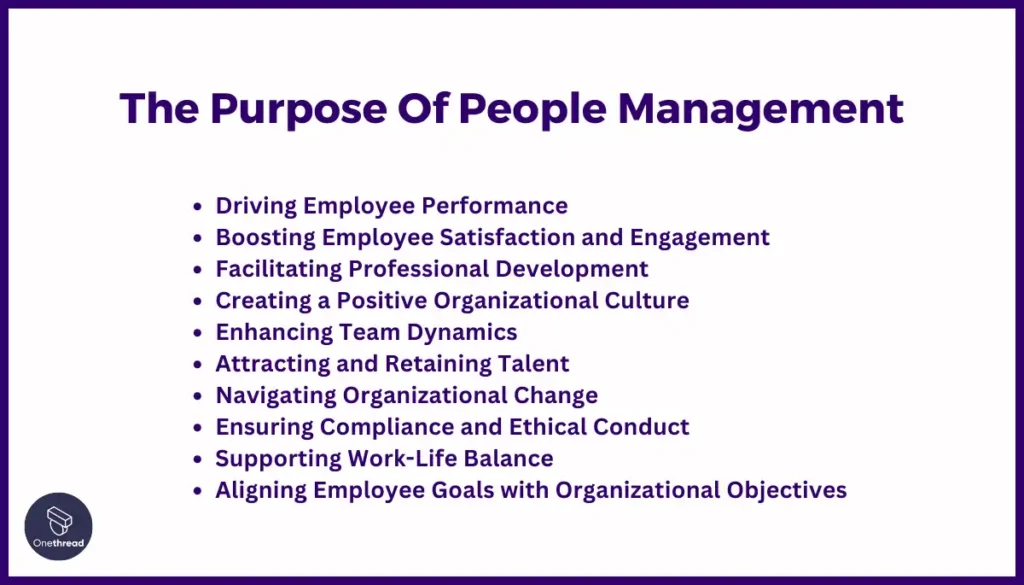
The purpose of people management encompasses a wide range of objectives focused on optimizing the workforce for organizational success, including:
- Driving Employee Performance: Strategically improving individual and team productivity to meet and exceed organizational targets.
- Boosting Employee Satisfaction and Engagement: Cultivating a workplace that motivates employees, increases their job satisfaction, and fosters a sense of belonging.
- Facilitating Professional Development: Providing training and development opportunities to enhance skills, knowledge, and career progression.
- Creating a Positive Organizational Culture: Developing a culture that values diversity, inclusion, innovation, and open communication.
- Enhancing Team Dynamics: Promoting collaboration, teamwork, and effective communication among employees to leverage collective strengths.
- Attracting and Retaining Talent: Implementing strategies to attract skilled professionals and retain valuable employees through recognition, rewards, and career opportunities.
- Navigating Organizational Change: Leading and supporting employees through changes in processes, technology, and organizational structure to minimize disruption and maintain productivity.
- Ensuring Compliance and Ethical Conduct: Adhering to legal requirements and ethical standards in managing human resources to protect the organization and its employees.
- Supporting Work-Life Balance: Encouraging policies and practices that balance work demands with personal life, enhancing employee well-being and satisfaction.
- Aligning Employee Goals with Organizational Objectives: Ensuring that employees understand how their roles contribute to the overall success of the organization, fostering a shared vision and purpose.
Which is More Vital for Organizational Success: People Management or Project Management?
People Management is like the engine of an organization, while Project Management is the steering wheel.
Both are vital! Without a strong engine, the car wouldn’t go anywhere. But without a steering wheel, it would just zoom chaotically.
People Management keeps your team happy, motivated, and working together smoothly. Project Management helps them set goals, stay organized, and deliver on time. So, it’s like they’re both essential for the car to reach its destination – happy employees delivering successful projects!
What Is The Difference Between Managing People And Managing Projects?
managing people focuses on nurturing individuals’ growth and performance while managing projects prioritizes achieving specific goals within strict parameters, utilizing different skills, and measuring success by distinct metrics.
Managing people and managing projects, while interconnected, involve distinctly different areas of focus and approaches.
This table shows the key differences between Project Management and People Management:
Aspect | Project Management | People Management |
Focus | Tasks and milestones | Team and individual development |
Goal | Completing projects efficiently and effectively | Developing a motivated and skilled team |
Key Skills | Planning, risk management, time management | Communication, empathy, leadership |
Approach | Structured, deadline-oriented | Flexible, people-oriented |
Outcome | Successful project delivery | High-performing and satisfied team |
This table highlights the distinct areas each management style concentrates on, their goals, required skills, their approaches, and the outcomes they aim for.
Project Management Principles:
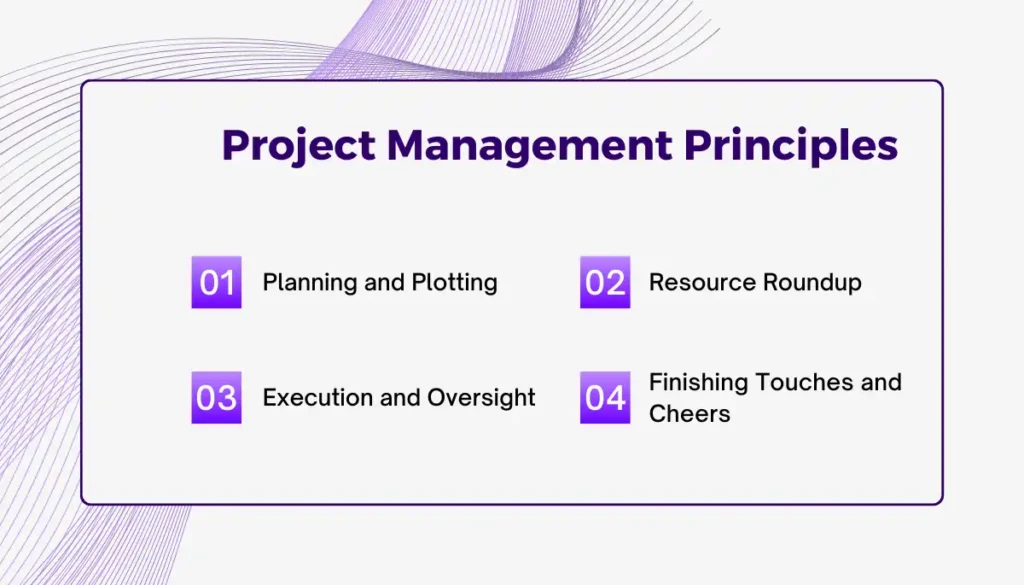
To gain success in project management we have to follow some key principles, those are:
Planning and Plotting:
This is where the blueprints come in! Defining goals, outlining tasks, and setting deadlines are all part of the project management game. Think of it as drawing your sandcastle masterpiece in the sand before you even grab a shovel.
Resource Roundup:
You need buckets, spades, and maybe even some seaweed for decorations! Project managers gather all the tools and resources needed to get the job done, just like you wouldn’t build a castle without sand and water.
Execution and Oversight:
Time to get digging! Project managers track progress, make sure everyone’s on task, and adapt to any unexpected waves (like a rogue beach ball!). They’re like the lifeguards of the sandcastle construction crew.
Finishing Touches and Cheers:
Castle complete! Project managers tie up loose ends, document everything, and (hopefully) celebrate a successful build with the team. It’s like putting a flag on top of your sandcastle and high-fiving your crab buddy!
People Management: The 5 C’s of Teamwork Magic:
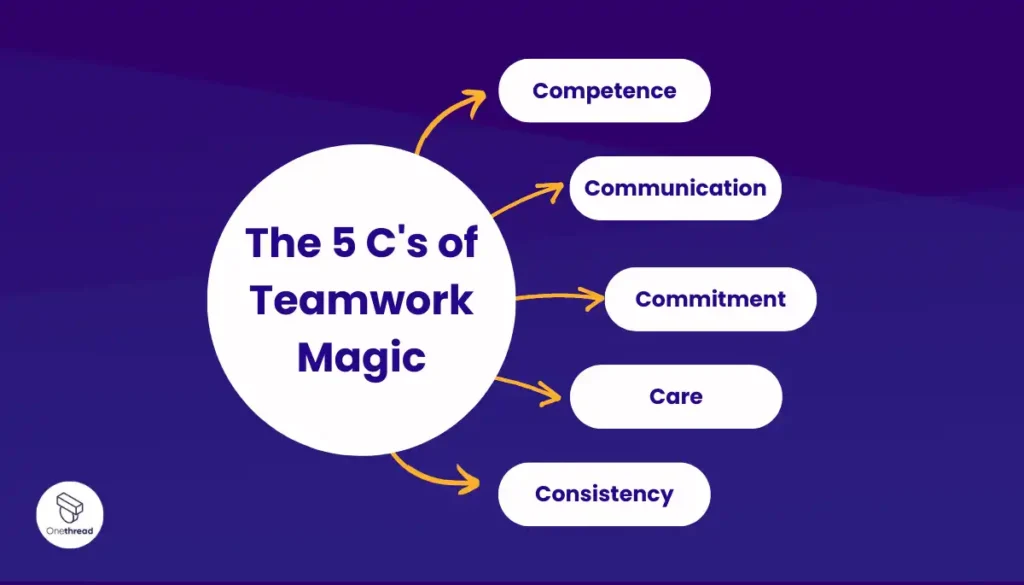
Now, let’s talk about that helpful crab! Here are the 5 C’s of people management that make your team feel valued and ready to build sandcastle empires:
Competence:
Skills and Knowledge: Ensuring team members are skilled and understand their jobs. It’s like making sure everyone knows the rules of the game.
Ongoing Training: Providing learning opportunities to keep improving. Think of it as leveling up in a video game.
Communication:
Clear Instructions: Making sure everyone understands what they need to do. It’s like giving clear directions to a friend.
Open Dialogue: Encouraging team members to share ideas and concerns. Imagine a roundtable where everyone gets to speak.
Commitment:
Dedication to Goals: Making sure everyone is focused on the team’s goals. It’s like everyone rowing a boat in the same direction.
Engagement in Work: Keeping the team interested and invested in their work. Think of it as keeping the game interesting and fun.
Care:
Supporting Team Members: Helping and looking out for each other. It’s like being a good friend who’s always there to help.
Work-Life Balance: Making sure everyone has time for work and fun. Imagine a seesaw perfectly balanced with work on one side and play on the other.
Consistency:
Reliable Leadership: Being a leader who is always fair and dependable. It’s like being the steady captain of a ship.
Steady Rules and Policies: Having rules that don’t keep changing. Think of it as playing a game where everyone knows the rules won’t suddenly change.
In short, Project Management is like being a captain navigating a ship to its destination, while People Management is like being a coach who helps a team play their best game. So, can a project manager become a people manager? Yes. Because both are important and work together to make sure the team and the project are successful.
Bridging the Gap Between Project and People Management
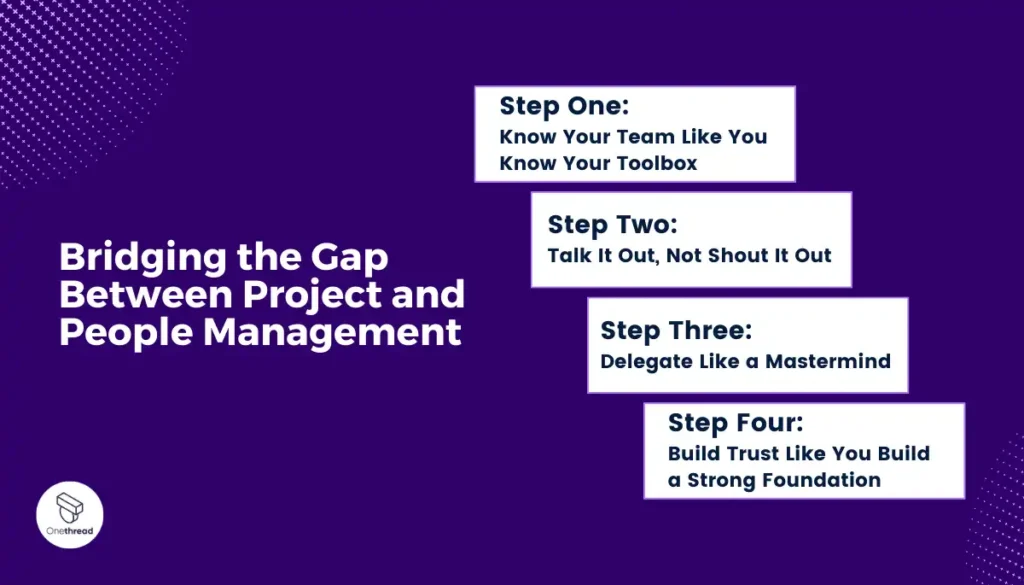
Collaborating on projects and people management for better results is like combining the powers of a superhero and a great coach. Here are the keys to bridging the divide of managing people as a project manager in a step-by-step guide:
Step One: Know Your Team Like You Know Your Toolbox:
- Strengths and Weaknesses: Everyone has unique strengths and weaknesses. Discover your team’s skills, personalities, and learning styles. Some are communication wizards, some are problem-solving ninjas, and some just need a little extra time to build confidence.
- Talk it Out, Not Shout it Out: Find out how your team prefers to communicate. Some love face-to-face chats, some thrive on emails, and some might even whisper instructions to their pet parrots (we’re not judging!).
- What Makes Them Tick? What drives your team? Is it recognition, friendly competition, or the chance to build the coolest treehouse ever? Figuring this out is like finding the hidden switch to activate their superpowers!
Step Two: Talk It Out, Not Shout It Out:
- Open Doors, Open Minds: Don’t keep secrets like a squirrel with a stash of acorns! Share your project goals, challenges, and progress openly with your team. It’s like giving them the blueprints for the treehouse, so everyone knows where they’re building and why.
- Feedback is a Friend, Not a Foe: Create a safe space where everyone can share ideas and constructive criticism without fear of judgment. Remember, even the best treehouse plans benefit from a few extra eyes and a friendly suggestion or two.
- Listen Up, Super Ears! Show genuine interest in your team’s concerns and perspectives. Active listening is like building a bridge of understanding – a bridge that can lead to even better treehouses!
Step Three: Delegate Like a Mastermind:
- Right Tool for the Right Job: Don’t ask the artistic butterfly to build the sturdy ladder – match tasks to your team’s skills and interests. Let the problem-solving ninjas tackle the tricky knots, and let the communication wizards craft the awesome welcome banner!
- Clear Instructions, Happy Builders: Set achievable goals and provide guidance, but also give your team the freedom to be creative and take ownership. Trust them to use their skills and build their part of the treehouse-like the awesome builders they are!
- High Fives All Around! Celebrating successes and recognizing contributions is like adding frosting to the treehouse cake! It boosts confidence, keeps everyone motivated, and makes building even more fun.
Step Four: Build Trust Like You Build a Strong Foundation:
- Lead by Example: Be a role model! Show integrity, accountability, and respect in your own actions. If you wouldn’t walk on a rickety plank, don’t expect your team to either.
- Mistakes are Stepping Stones, Not Stumbling Blocks: Encourage learning from failures. Create an environment where risks are encouraged and mistakes are seen as chances to grow. Remember, even the best treehouse builders need to learn from a wobbly branch or two!
- Conflict Resolution Champions: Foster a culture of respectful communication and joint decision-making. When disagreements arise, don’t turn them into treehouse wars! Help your team work through conflicts constructively and find solutions that everyone can climb on board with.
By understanding your team, communicating openly, delegating tasks well, and building trust, you can combine project and people management for greater success. It’s like being both a coach and a team player, helping everyone work together towards a common goal.
What Common Mistakes Do Project Managers Make in Handling Human Resources?
Project managers are like coaches, leading teams to victory. But sometimes, they make mistakes with their team members, just like a coach forgetting the playbook! Here are a few common blunders:
- Micromanaging: Constantly checking up and bossing around makes everyone grumpy. Trust your team to do their best, and be there to guide and support them, not hover!
- Communication Crash: Not keeping everyone informed or giving unclear instructions leads to confusion and chaos. Talk openly and honestly, and make sure everyone’s on the same page!
- Motivation Meltdown: Ignoring team needs and feelings can zap everyone’s energy. Celebrate wins, offer encouragement, and listen to their concerns to keep spirits high!
- Feedback Fumble: Skipping feedback or giving only criticism is like skipping dessert – no fun! Offer regular, constructive feedback to help people grow and feel appreciated.
- One-Size-Fits-All Trap: Treating everyone the same ignores their unique strengths and weaknesses. Tailor your approach to each team member to get the best out of them!
Remember, great teams are built on trust, communication, and appreciation. By avoiding these mistakes, project managers can become true leaders, guiding their teams to success!
Overcoming Common Challenges of People Management
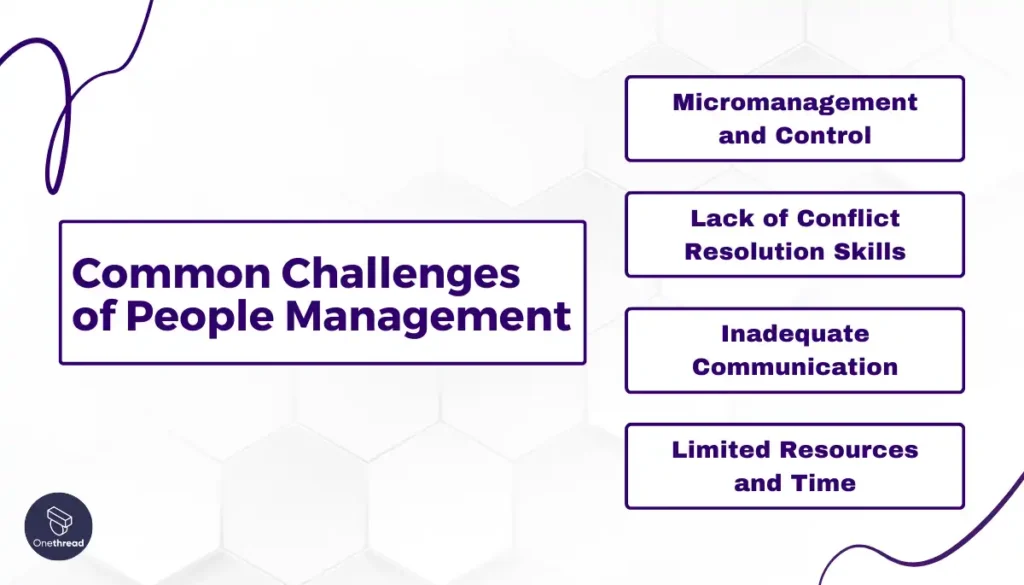
To overcome common challenges of people management follow these tips and tricks:
Micromanagement and Control:
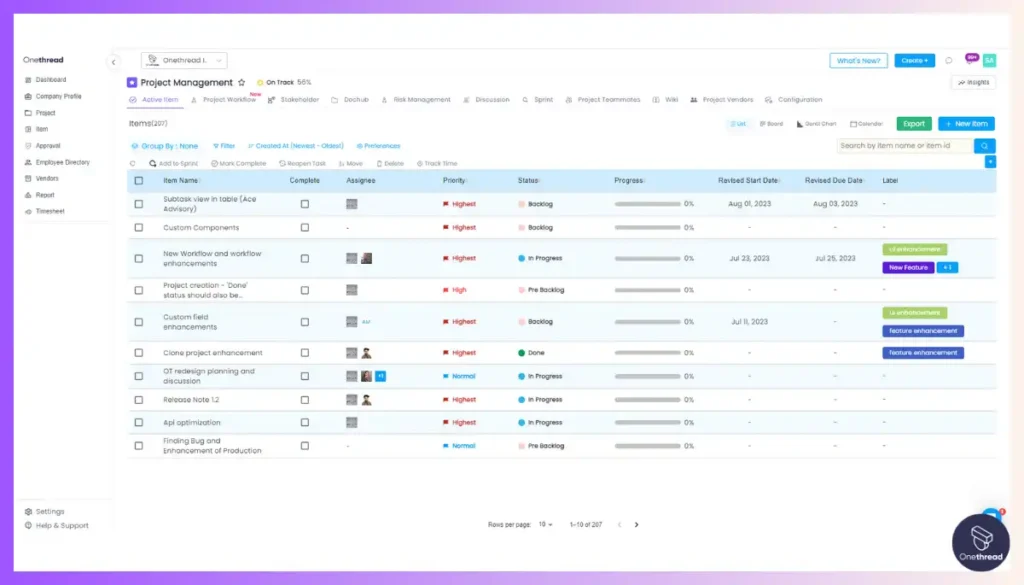
Ease Up on the Reins: Micromanagement is like watching over someone’s shoulder all the time. It’s not fun for them. Trust your team and give them space to work.
Empower with Autonomy: Let team members make decisions. It’s like letting them choose their own adventure in a story. They’ll feel more involved and responsible.
Onethread, with its comprehensive task management and communication features, can help project managers avoid micromanagement by empowering team members with ownership and facilitating open communication.
Lack of Conflict Resolution Skills:
Navigating Through Disagreements: Conflict is like a tangled knot. Learning how to untangle it calmly and positively is key. Teach your team how to talk through disagreements.
Finding Positive Solutions: Encourage your team to find solutions together. It’s like solving a puzzle as a group, where everyone has a piece of the answer.
Inadequate Communication:
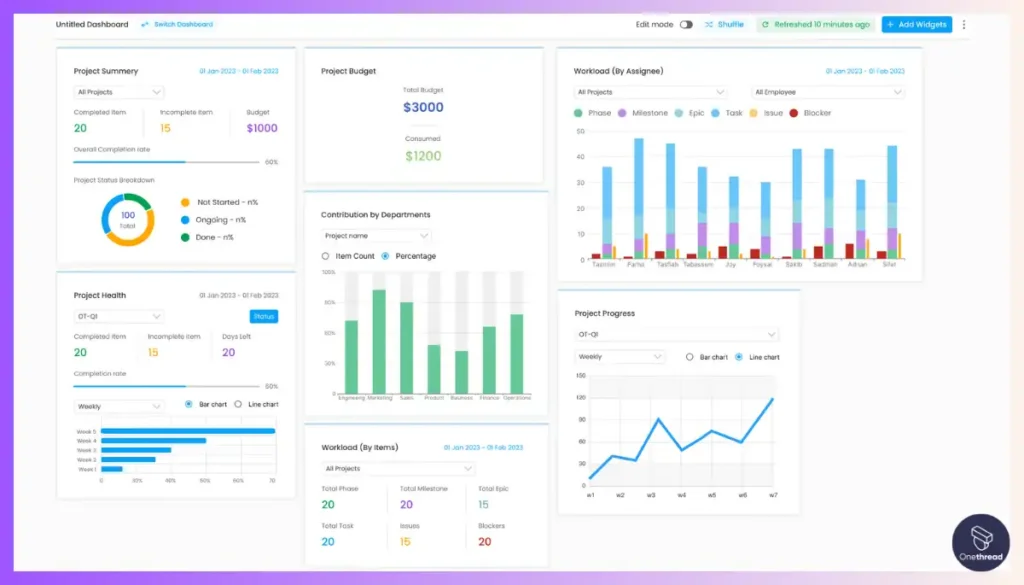
Better Tools and Techniques: Think of communication as a toolbox. Use different tools like meetings, emails, or chats, depending on what works best for your team.
Understand Different Styles: Everyone communicates differently. It’s like speaking different languages. Learn to speak everyone’s ‘language’ for better understanding.
Onethread’s central dashboard and discussion forum provide a platform for regular feedback and open communication, ensuring everyone is on the same page and progress is transparent.
Limited Resources and Time:
Smart Resource Management: When you have limited things like money or materials, use them wisely. It’s like playing a game where you have to make the best moves with what you have.
Maximizing Performance: Use your time and resources in the best way possible. It’s like making a great meal with just a few ingredients.
Overcoming these challenges is like navigating a ship through stormy seas. By trusting your team, resolving conflicts, communicating well, and using resources wisely, you can sail smoothly to success. It’s all about finding the right balance and working together as a team.
Role of Project Management Tool in People Management
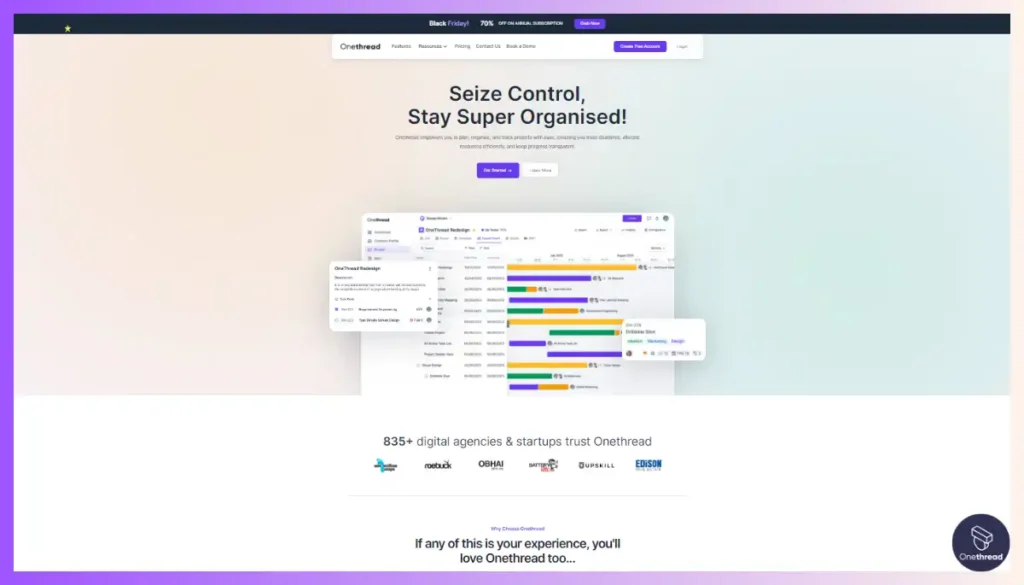
As a project manager, you wear many hats. You juggle tasks, deadlines, budgets, and most importantly, your people. While technical skills are crucial, true project success hinges on your ability to lead, motivate, and build trust with your teams. But let’s face it, traditional project management tools often fall short when it comes to the human side of the equation.
This is where Onethread steps in, not just as a task management platform, but as your people-centric project management partner. It goes beyond managing deadlines and checklists to empowering you to manage, motivate, and connect with your team on a deeper level. Here’s how:
1. Building Trust and Transparency:
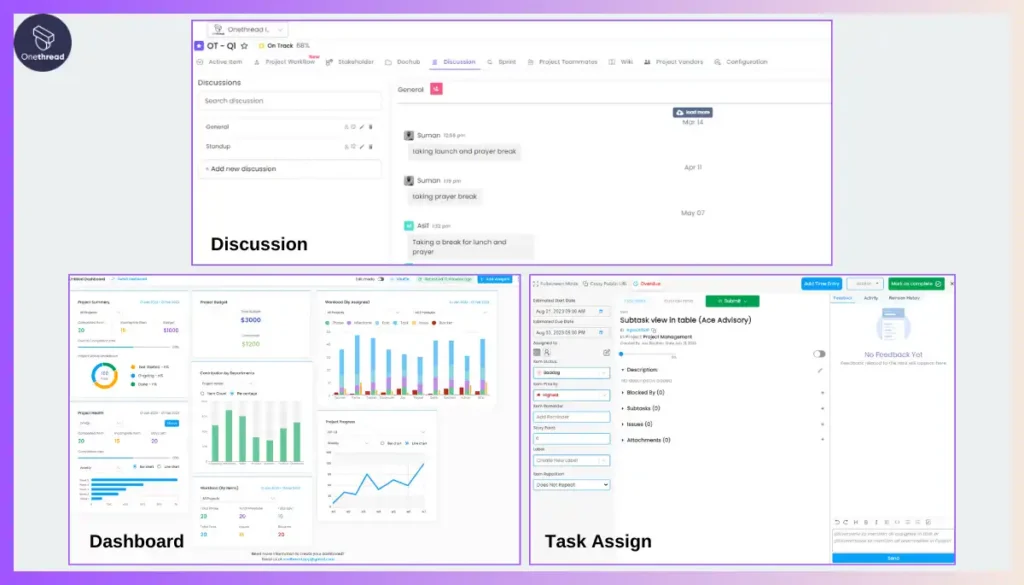
Micromanagement is the silent killer of team morale. Onethread breaks down communication barriers with features like real-time discussion forums, clear task assignments, and customizable dashboards. Everyone is kept in the loop, fostering trust and reducing the need for constant oversight. Think of it as opening the windows and letting fresh air and collaboration flood in.
2. Empowering Ownership and Motivation:
Gone are the days of one-size-fits-all project plans. Onethread allows you to tailor tasks and workflows to individual strengths and preferences. Team members feel valued and invested, taking ownership of their work and driving motivation naturally. It’s like handing out paintbrushes instead of blueprints, letting your team create their masterpiece in their own way.
3. Celebrating Progress and Growth:
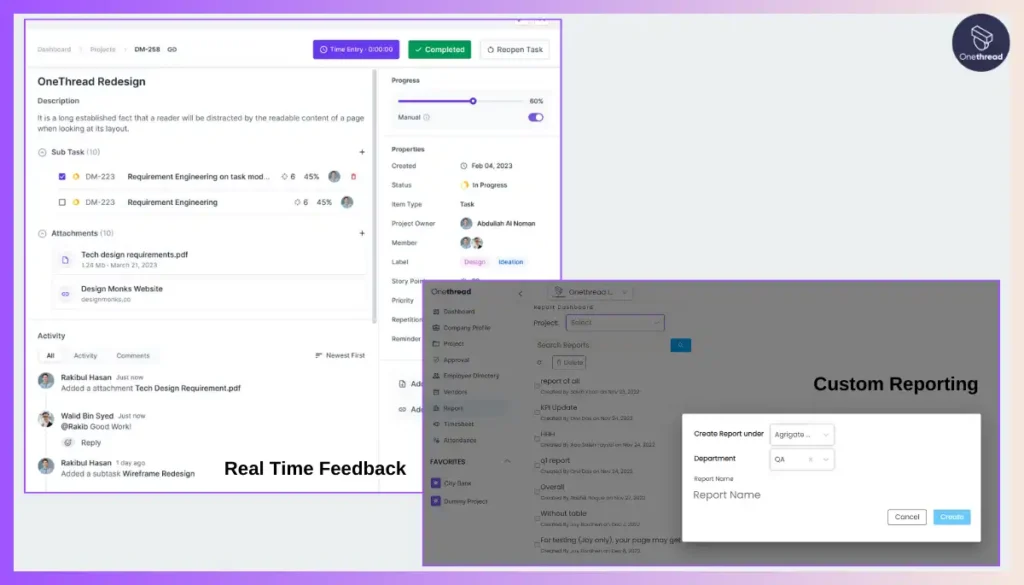
Recognition is the fuel that keeps the fire burning. Onethread helps you acknowledge individual and team achievements through discussion boards, real-time feedback channels, and customizable reports. Seeing their efforts valued keeps everyone engaged and striving for their best. It’s like cheering on every step of the climb, making the summit even sweeter.
4. Fostering Open Communication and Conflict Resolution:
Disagreements happen, but they needn’t be dealbreakers. Onethread provides a safe space for constructive discussions and conflict resolution through its communication tools and collaborative features. It helps you navigate sensitive situations with transparency and empathy, paving the way for stronger bonds and productive outcomes. Think of it as a virtual mediator, guiding your team through disagreements and towards solutions.
5. Building Stronger Connections and Team Spirit:
A project team isn’t just a collection of individuals; it’s a family. Onethread fosters team spirit by encouraging informal interactions through discussion forums, virtual coffee breaks, and even fun features like emoji reactions. It helps you build camaraderie, celebrating both personal wins and collective victories. It’s like creating a virtual campfire where everyone can gather, share stories, and feel part of something bigger.
Project management is about more than just ticking off boxes. It’s about inspiring and empowering your team to achieve their best. Onethread understands this, offering a platform that not only simplifies task management but also strengthens people’s connections. It’s a tool that lets you wear your project manager hat with pride, knowing you’re not just leading a team, but building a community.
With Onethread as your ally, people management becomes less of a challenge and more of a fulfilling journey. It’s time to ditch the outdated tools and embrace a platform that puts people at the heart of project success.
Try Onethread
Experience Onethread full potential, with all its features unlocked. Sign up now to start your 14-day free trial!
Future Directions: Evolving Trends in Project and People Management
Future Directions_ Evolving Trends in Project and People Management..webp
The world of project and people management is buzzing with exciting new trends, and here’s a sneak peek at what’s coming:
Tech Tools Taking Over:
- Virtual Workspaces on Steroids: Imagine collaborating with your team from anywhere, anytime, with holograms and interactive 3D models instead of flat screens. That’s the future of collaboration, where distance becomes a distant memory!
- AI Assistants as Your Sidekicks: Think of a super-smart robot that helps you plan, schedule, and even analyze team dynamics. AI will be your project management sidekick, freeing you up to focus on the human side.
- Data-Driven Decisions: Forget gut feelings and guesswork! Project management will be all about using real-time data to make informed decisions, like predicting risks and optimizing team performance.
Project Managers: The New People Whisperers:
- From Taskmasters to Coaches: The future project manager is less about bossing people around and more about guiding, motivating, and inspiring them. Think of it as becoming a superhero coach, helping your team reach their full potential.
- Building Diverse and Inclusive Teams: The future belongs to teams with different backgrounds and perspectives. Project managers will be the champions of diversity, ensuring everyone feels valued and heard.
- Lifelong Learning Warriors: The world keeps changing, and so should you! Project managers will need to embrace continuous learning to stay ahead of the curve and adapt to new technologies and trends.
Getting Ready for the Future:
- Embrace the Change Wave: Don’t be afraid of new things! The future of project and people management is exciting, so jump in and start exploring these new trends.
- Invest in Your Team: The best tech tools are useless without a great team. Invest in training, development, and building a positive work environment to make your team future-proof.
- Focus on the Human Touch: Even with all the fancy tech, remember that project management is still about people. Keep communication open, show empathy, and build trust – that’s what makes a truly successful team.
So, are you ready to join the future of project and people management? It’s going to be an amazing ride, filled with exciting challenges and incredible opportunities.
Practical Insights: Real-World Applications and Case Studies
Alright, we’ve talked about fancy future trends and superhero powers, time to move beyond blueprints and see how these ideas actually play out in the real world!
Case Studies: Teamwork Triumphs!
- Tech Startup Rocketship: A young tech company, known for its open communication and focus on employee well-being, used collaborative project management tools and flexible work schedules to boost productivity and creativity, skyrocketing to success.
- Construction Crew Champions: A construction team, plagued by communication breakdowns and low morale, introduced regular team-building activities and empowered workers with decision-making, leading to a dramatic decrease in errors and a surge in project completion speed.
- Global Marketing Synergy: A multinational marketing team, struggling with cultural differences and conflicting priorities, implemented a system of cross-cultural training and open communication channels, fostering a sense of unity and achieving record-breaking marketing campaigns.
Lessons Learned: From Stumbles to Success!
- Micromanagement Mayhem: A project manager who micromanaged every task led to a frustrated and unproductive team, highlighting the importance of trust and empowering individuals.
- Communication Catastrophe: A lack of clear communication about project goals and deadlines resulted in confusion and missed deadlines, emphasizing the need for open and transparent communication.
- Diversity Denied: A team lacking diversity in skills and perspectives struggled to generate creative solutions, showcasing the value of embracing different viewpoints and experiences.
Expert Insights: Wisdom from the Wise:
- “The best project managers are the ones who can make their team feel like heroes, not just cogs in a machine.” – Sarah Jones, CEO of Innovation Labs.
- “Diversity is not just a buzzword; it’s the secret weapon of successful teams. Embrace different perspectives and watch your projects soar.” – Michael Lee, Author of “The Power of Team Synergy.”
- “Technology is a tool, not a savior. Invest in your team, build trust, and you’ll have a project management powerhouse that no fancy app can replace.” – Emily Garcia, Project Management Consultant.
FAQs
What are the main 5 roles of project management?
Project management primarily involves planning and organizing a project, leading the team, managing the budget, ensuring quality, and managing risks. These roles ensure that projects are completed successfully, within budget, and on time.
How to become a project manager without experience?
To become a project manager without experience, start by learning project management fundamentals through online courses or certifications. Gain practical skills by volunteering for project roles, participating in internships, and seeking mentorship from experienced project managers. Building a network and showcasing project management skills in any job can also open opportunities.
What is Training in People Management?
Training in people management involves learning how to effectively lead, motivate, and support a team. It covers communication skills, conflict resolution, performance management, and team-building techniques. This training helps in developing a productive and positive workplace environment.
Can a Project Manager Become a People Manager?
Yes, a project manager can become a people manager. The transition involves shifting focus from managing tasks and timelines to leading, developing, and motivating a team. Skills in communication, empathy, and team management are crucial for this transition.
What is the difference between PM and PMO?
The difference between a Project Manager (PM) and a Project Management Office (PMO) is that a PM focuses on managing individual projects, ensuring they are completed successfully. In contrast, a PMO oversees the overall project management processes and standards across an organization, providing guidance and support to all PMs.
What are the features of people management?
Features of people management include effective communication, empathy, conflict resolution, team motivation, performance management, and leadership skills. It focuses on developing a strong, cohesive team and creating a supportive work environment.
What is Leadership and People Management?
Leadership and people management involve guiding, inspiring, and supporting a team to achieve goals. It includes setting a vision, motivating team members, and creating a positive work culture, ensuring the team’s growth and success.
What are good people management skills?
Good people management skills include effective communication, empathy, conflict resolution, the ability to motivate and inspire, strong leadership, and the ability to provide constructive feedback. These skills are essential for creating a positive team environment and achieving organizational goals.
Bottom Line
Successfully merging project and people management is key to organizational triumph. By fostering effective communication, understanding team dynamics, and embracing future trends, managers can unlock their team’s full potential.
OneThread plays a pivotal role in this integration, offering the necessary tools and support to navigate the complexities of modern project and people management seamlessly.
